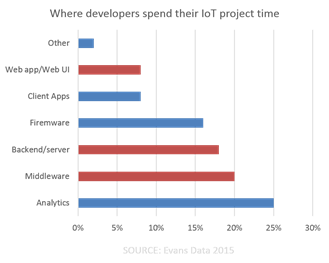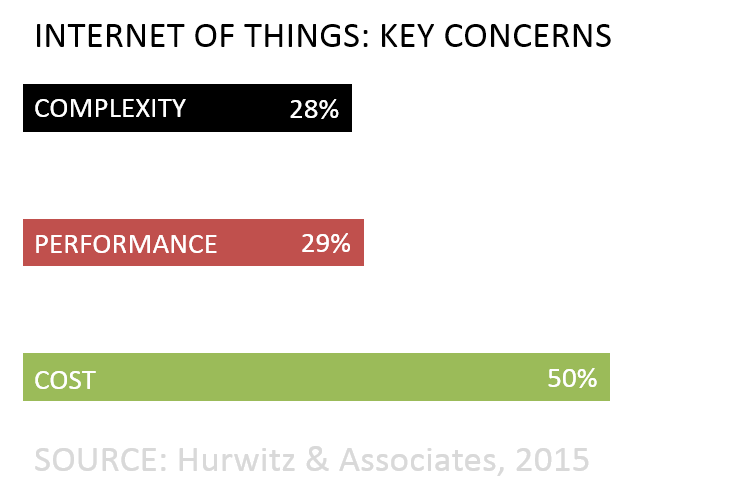Des objets qui parlent à des objets qui parlent à des applications
Un capteur de gluten portable.
Haut-parleur sans fil dans une ampoule.
Le nombre d’« objets » qui envahissent le marché aujourd’hui est impressionnant, et chaque jour apporte des nouveautés parfois inattendues. L’ampleur des innovations autour de l’Internet des objets vous donne à penser que toutes les ressources engagées se concentrent principalement sur les objets eux-mêmes.

Bien sûr, vous savez que je vais dire maintenant que ce n’est pas du tout le cas. Parce que vous me connaissez maintenant, je suis comme ça.
La réalité est que, même si les objets qui parlent aux objets constituent un élément important de l’IoT, l’autre côté du marché est certainement celui des applications avec lesquelles les objets parlent (et qui leur parlent). Selon l' enquête Evans Data 2015 Global IoT Development, près de la moitié des développeurs travaillent sur des applications de support : middleware, systèmes back-end et interfaces utilisateur Web pour la gestion et le contrôle. Le type de projet le plus cité comme étant au centre du développement de l’IoT ? Automatisation du lieu de travail.
Si le côté ludique de l’IoT réside certainement dans les nouveaux gadgets et jouets avec lesquels jouer (allez, qui n’aime pas les gadgets ?), le côté commercial de l’IoT réside dans les applications, la productivité et l’optimisation des processus. Des préoccupations commerciales qui sont, en fait, aussi cruciales pour le succès de l’IoT que le dernier gadget qui va rendre les consommateurs fous.
Ce n’est pas une notion nouvelle. Début 2014, Gartner avait identifié cette réalité et l’applicabilité de l’IoT aux opérations commerciales, en particulier :
« L'IoT connecte des actifs distants et fournit un flux de données entre l'actif et les systèmes de gestion centralisés. Ces actifs peuvent ensuite être intégrés dans des processus organisationnels nouveaux et existants pour fournir des informations sur le statut, l’emplacement, la fonctionnalité, etc. Les informations en temps réel permettent une compréhension plus précise de l'état et améliorent l'utilisation et la productivité grâce à une utilisation optimisée et à une prise en charge décisionnelle plus précise. « L’analyse des données et des activités commerciales permet de mieux comprendre les flux de données des besoins commerciaux provenant de l’environnement IoT et permet de prévoir les fluctuations des données et des informations enrichies par l’IoT. » [c’est moi qui souligne]
Même si nous voulons tous considérer l’Internet des objets comme notre dernier terrain de jeu technologique (et c’est le cas), il s’agit d’une affaire sérieuse, avec de graves implications pour le centre de données qui sera capable de faire évoluer, de sécuriser et de fournir l’avant-dernier produit de l’IoT : ses données. Aujourd’hui, la principale préoccupation des entreprises n’est pas de savoir comment productiser et monétiser l’IoT, mais plutôt comment l’exploiter pour produire une plus grande valeur à partir des systèmes existants et optimiser les processus commerciaux en prélude à la croissance. Si le processus ne peut pas évoluer, l’entreprise ne le pourra pas non plus.

Ce n’est pas très différent des facteurs moteurs de DevOps et d’Agile : les processus régissant le développement et le déploiement n’étaient tout simplement pas suffisamment évolutifs pour répondre à la croissance de la demande. Ils ont donc adopté des outils et des technologies, automatisé l'orchestration et réinjecté des données dans la boucle pour les optimiser jusqu'à ce qu'ils puissent les livrer et les déployer des dizaines de fois par jour. Désormais, les entreprises doivent faire la même chose, non seulement dans le centre de données, mais également dans l’atelier de fabrication et sur le terrain, sur les routes, dans leurs chaînes d’approvisionnement et dans leurs canaux de distribution.
Et les « choses » sont censées être la façon dont cela va se passer.
Ce qui signifie que vous, en informatique, allez devoir prendre en charge les applications en back-end avec leurs composants middleware et de stockage de données. Vous allez devoir atteindre de nouveaux sommets et concevoir de nouvelles solutions pour aider à atténuer leurs principales préoccupations en matière de performances et de coûts.
Le centre de données migre peut-être partiellement vers le cloud (tous les rapports confirment qu'où il y a de l’IoT, il y a du cloud…) pour soutenir ces applications et les énormes volumes de données générées, mais la DSI reste responsable de concevoir des services et des architectures qui facilitent le déploiement et la livraison de ces nouvelles applications back-end web, avec l’échelle, la sécurité et la performance nécessaires pour garantir que les solutions produisent les résultats attendus : optimiser l’entreprise. Que les services soient déployés dans le centre de données, dans le cloud ou une combinaison des deux, il faudra continuer à les mettre en œuvre comme toujours. L’essentiel est de trouver une solution qui relie centre de données et cloud, offrant une cohérence opérationnelle quel que soit l’emplacement de l’application, pour assurer une gestion fluide des apps, des ressources et des services dans un environnement cloud hybride.
Les choses parleront aux choses, oui. Mais tout aussi souvent, ils parleront à des applications, et vice-versa. Ce sont ces applications qui auront l’impact le plus direct sur l’informatique traditionnelle dans chaque entreprise. Parce que lorsqu'il s'agit de fournir, de faire évoluer et de sécuriser des applications , qu'elles communiquent avec des objets ou des personnes, c'est toujours le service informatique qui est chargé de le faire.
